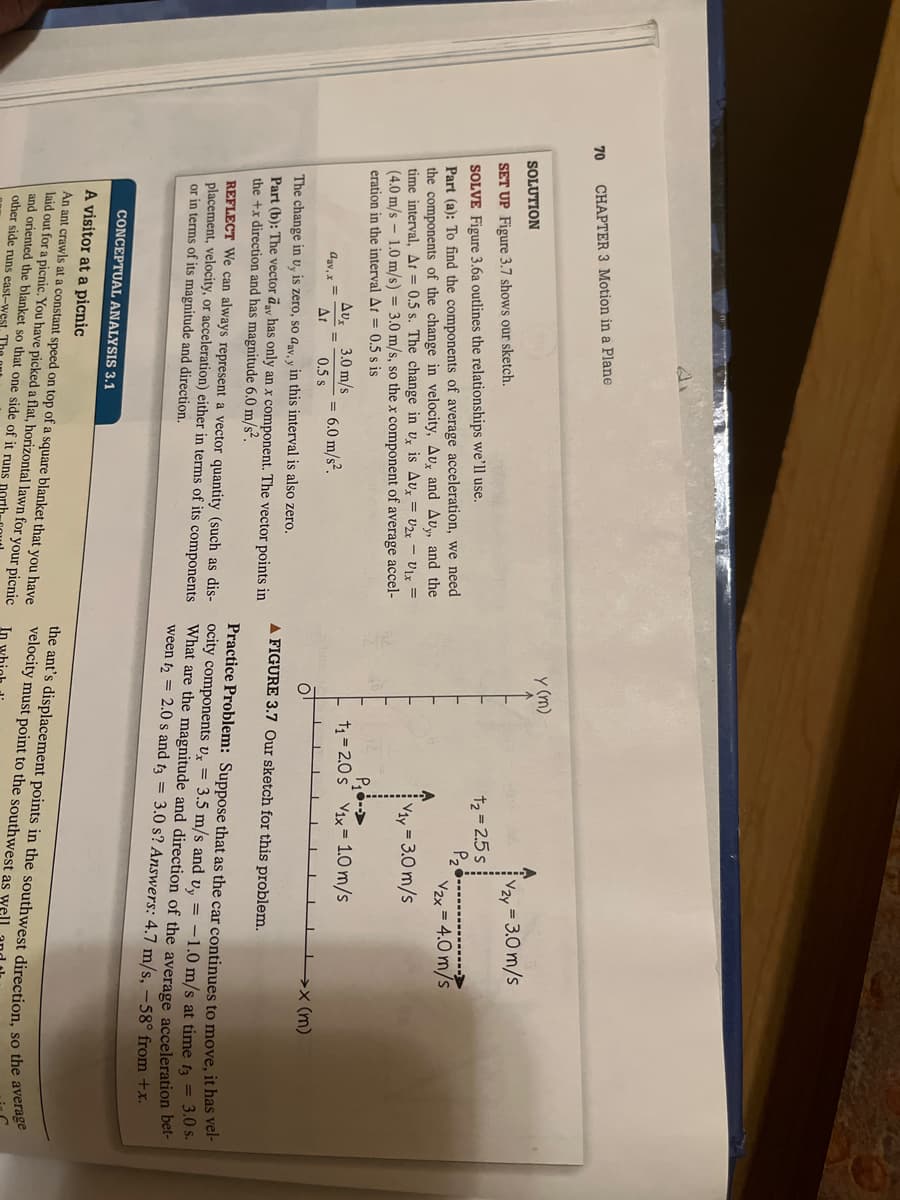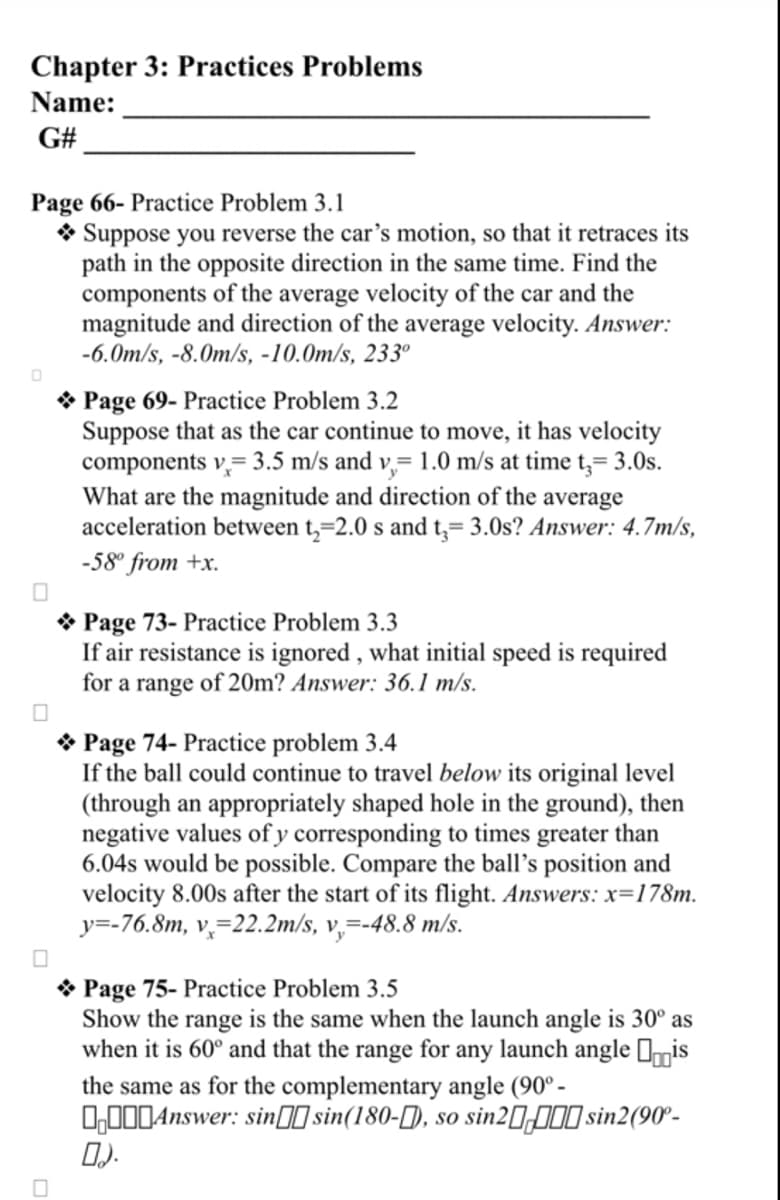Page 69- Practice Problem 3.2 Suppose that as the car continue to move, it has velocity components v₂= 3.5 m/s and v, 1.0 m/s at time t,= 3.0s. What are the magnitude and direction of the average acceleration between t₂=2.0 s and t₂= 3.0s? Answer: 4.7m/s, -58⁰ from +x.
Page 69- Practice Problem 3.2 Suppose that as the car continue to move, it has velocity components v₂= 3.5 m/s and v, 1.0 m/s at time t,= 3.0s. What are the magnitude and direction of the average acceleration between t₂=2.0 s and t₂= 3.0s? Answer: 4.7m/s, -58⁰ from +x.
Related questions
Question
Only practice problem 3.2
Second photo had background info for problem.

Transcribed Image Text:70
CHAPTER 3 Motion in a Plane
SOLUTION
SET UP Figure 3.7 shows our sketch.
SOLVE Figure 3.6a outlines the relationships we'll use.
Part (a): To find the components of average acceleration, we need
the components of the change in velocity, Au, and Avy, and the
time interval, At = 0.5 s. The change in u, is Av, U2x - Ulx =
(4.0 m/s 1.0 m/s) = 3.0 m/s, so the x component of average accel-
eration in the interval At = 0.5 s is
aav, x=
Aux
At
3.0 m/s
0.5 s
= 6.0 m/s².
The change in u, is zero, so dav, y in this interval is also zero.
Part (b): The vector day has only an x component. The vector points in
the +x direction and has magnitude 6.0 m/s².
REFLECT We can always represent a vector quantity (such as dis-
placement, velocity, or acceleration) either in terms of its components
or in terms of its magnitude and direction.
CONCEPTUAL ANALYSIS 3.1
A visitor at a
picnic
An ant crawls at a constant speed on top of a square blanket that you have
laid out for a picnic. You have picked a flat, horizontal lawn for your picnic
and oriented the blanket so that one side of it runs por
other side runs east-west.
y (m)
t₂ = 2.5 s
P₂
V2y = 3.0 m/s
V2x = 4.0 m/s
V₁y = 3.0 m/s
P₁-->
t₁ = 2.0 S V₁x = 1.0 m/s
A FIGURE 3.7 Our sketch for this problem.
>x (m)
Practice Problem: Suppose that as the car continues to move, it has vel-
ocity components Ux = 3.5 m/s and uy = -1.0 m/s at time 13 = 3.0 s.
What are the magnitude and direction of the average acceleration bet-
ween t2 = 2.0 s and t3 = 3.0 s? Answers: 4.7 m/s, -58° from +x.
the ant's displacement points in the southwest direction, so the average
velocity must point to the southwest as well

Transcribed Image Text:Chapter 3: Practices Problems
Name:
G#
Page 66- Practice Problem 3.1
Suppose you reverse the car's motion, so that it retraces its
path in the opposite direction in the same time. Find the
components of the average velocity of the car and the
magnitude and direction of the average velocity. Answer:
-6.0m/s, -8.0m/s, -10.0m/s, 233⁰
0
Page 69- Practice Problem 3.2
Suppose that as the car continue to move, it has velocity
components v= 3.5 m/s and v, 1.0 m/s at time t,= 3.0s.
What are the magnitude and direction of the average
acceleration between t₂=2.0 s and t₂= 3.0s? Answer: 4.7m/s,
-58⁰ from +x.
→ Page 73- Practice Problem 3.3
If air resistance is ignored, what initial speed is required
for a range of 20m? Answer: 36.1 m/s.
Page 74- Practice problem 3.4
If the ball could continue to travel below its original level
(through an appropriately shaped hole in the ground), then
negative values of y corresponding to times greater than
6.04s would be possible. Compare the ball's position and
velocity 8.00s after the start of its flight. Answers: x=178m.
y=-76.8m, v, 22.2m/s, v,=-48.8 m/s.
Page 75- Practice Problem 3.5
Show the range is the same when the launch angle is 30° as
when it is 60° and that the range for any launch angle is
the same as for the complementary angle (90°-
Answer: sinsin(180-), so sin2000 sin2(90°-
Expert Solution
This question has been solved!
Explore an expertly crafted, step-by-step solution for a thorough understanding of key concepts.
This is a popular solution!
Trending now
This is a popular solution!
Step by step
Solved in 2 steps
